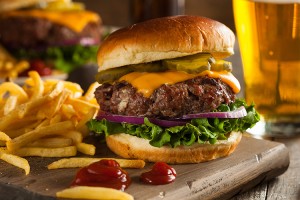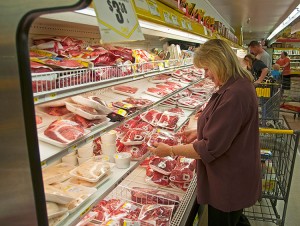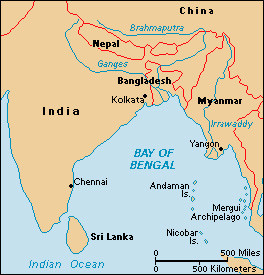The Future of Meat
Monday, July 15th, 2019July 15, 2019
Food fads come and go every year, but for most Americans, meat always has a starring role on the dinner plate. Our meat habit has a cost, however: it can harm both our health and the environment. Cutting back on meat consumption, or cutting meat out completely, goes a long way toward helping the environment and our bodies—as well as the animals butchered for meat. Searching for meat alternatives, several food industry startups are offering new forms of meat and meat substitutes that are redefining meat as we know it—and they may change forever the way we produce and consume food. Lab-grown meat or plant-based substitutes are now often indistinguishable from the flesh of animals, and the future of meat may be one that does not involve animals at all.

New lab-grown and plant-based meats offer alternatives to traditional meats such as the beef used to make this hamburger. Credit: © Brent Hofacker, Shutterstock
Most nutritionists consider meat to be an important component of a well-balanced diet. Meat supplies vitamins, minerals, and fats necessary for good health and growth. Meat also provides an especially good source of protein. However, meat is not universal in the American diet. Many vegetarians avoid eating meat because they believe it is wrong to kill animals for food or they consider meat to be unhealthy. Many vegetarians, however, will consume such animal products as cheese and eggs. Vegans, on the other hand, eat an entirely plant-based diet and avoid all foods derived from animals, including honey and milk.
In the United States, per capita (per person) meat consumption has grown steadily to about 95 pounds (43 kilograms) per year—more than double the amount consumed in 1960. Each year, the United States raises more than 30 million beef cattle, 73 million hogs, and a staggering 9 billion chickens. The feeding, housing, transportation, and processing of these animals into food is a global industry consuming enormous amounts of energy resources and creating vast amounts of pollution. The meat industry is also one of the largest sources of greenhouse gas emissions that contribute to climate change.

Lab-grown or cell-cultured meats may soon rival traditional meats in U.S. supermarkets. Credit: © Tony Hertz, Alamy Images
Food companies have created a variety of meat substitutes over the years, from veggie hot dogs and bacon to tofurkey (tofu turkey). MorningStar Farms, owned by food industry giant Kellogg, has been producing meat substitutes since 1975. Many people consider such plant-based products to be a healthier alternative to meat, especially such red meats as beef, pork, and lamb. In general, red meats have more saturated fat, which can raise blood cholesterol and contribute to heart disease. Medical research has shown that higher meat consumption is linked to a greater incidence of certain cancers. Until now, most meat substitutes have had limited appeal. Made with products like TVP (textured vegetable protein), a by-product of soybean oil production, these products are often found to be dry and lack the look, juicy texture, and taste of meat.

Meat substitutes have long included such products as tofu, a food made of soybean curds pressed into cakes or blocks. Credit: © Shutterstock
Beyond Meat and Impossible Foods, however, are food industry startups with new vegan-friendly products that are virtually indistinguishable from traditional meat. Beyond Meat makes its substitute beef using pea protein isolate, coconut oil, and canola oil in a ratio that mimics the fat and protein content of ground beef. Impossible Foods uses soy and potato protein, sunflower seed oil, and coconut oil. Other ingredients include water, salt, and methylcellulose, a substance derived from plant fiber that is widely used in the food industry as a thickener and emulsifier. (An emulsifier bind liquids in an emulsion, a mixture of liquids that do not dissolve in each other.) Beyond Meat uses natural coloring agents derived from beets to provide the juicy appearance of a rare-cooked burger. Impossible Foods uses genetically modified yeast to make soy leghemoglobin (also called a heme), a molecule identical to the blood-red pigment in meat, to provide an appetizing color, meaty flavor, and a juicy sizzle.
Beyond Meat and Impossible Foods hamburger substitutes have modestly better nutritional profiles compared to beef burgers. Both meatless products have fewer calories, slightly less fat, and similar amounts of high-quality protein. The meatless burgers also provide a modest amount of dietary fiber. Beyond and Impossible emphasize the benefits of their products for health, animal welfare, and combatting climate change. However, should we assume that such ultra-processed foods are always better?
In 2019, government health agencies in Europe and the United States released reports that linked higher consumption of ultra-processed foods to an increase in rates of obesity and cardiovascular disease. Such processed foods, including canned foods and most snacks, are made with highly refined ingredients and many additives to improve flavor, texture, and shelf life. Impossible and Beyond burgers are made from an extruded paste of mechanically extracted proteins mixed with vegetable and seed oils, spices, and other ingredients to add flavor and provide meat-like texture. Each lists at least 20 ingredients. Some health experts also worry that they may include several potential allergens that could cause problems for sensitive individuals, although there have not yet been any reported issues.
There is also a certain suspicion that tends to surround mass-produced food substitutes meant to replaced cherished favorites. While meat has a complex composition and structure—made up of amino acids (the building blocks of protein), fats, minerals, vitamins, and water all woven together—it is usually considered a single ingredient—a whole food that is proven safe to eat. Companies producing plant-based meat substitutes are not immune from being labeled “Frankenfoods” by advocacy groups if their production processes are too complex or secretive.
In 2018, the American hamburger chain Burger King began selling an Impossible version of their trademark “Whopper” hamburger in several Midwest cities on a trial basis. The chain has plans to make the sandwich available nationally by the end of 2019. Burger King will do a plant-based burger for European locations, too–but it cannot use Impossible burgers there because of the use of genetically modified yeast. In 2018, the European Court ruled that gene-edited crops are subject to the same strict regulations Europe has for genetically modified organisms (GMOs). European real food advocacy groups worry that products like the Impossible burger will increase public acceptance of genetically engineered food and highly-processed food over whole foods grown by farmers.

A food researcher tastes a hamburger patty made from meat grown in a laboratory. The patty was formed from protein strands grown by cattle cells cultured in a laboratory, rather than by slaughtering and butchering a cow. Credit: © Toby Melville, Reuters/Landov
As plant-based meat substitutes gain in popularity, some food industry experts believe that the future of meat is in cell cultures. In 2013, scientists in the Netherlands took cells from a cow and produced muscle fibers in a laboratory—the first lab-grown meat. That summer, they revealed their work to the world in a news conference. As the press looked on, a chef prepared the laboratory product into a hamburger. Today, proponents of lab-grown meat say the technology has the potential to produce real beef, pork, chicken, and fish grown from a small cell sample, eliminating the need for farms, feedlots, slaughterhouses, or even animals. Some animal-welfare groups favor this “cellular agriculture” because it diminishes the need to kill animals to provide food for human beings. They see cellular agriculture as a way to establish a more humane world without livestock farms and slaughterhouses.
New Harvest, a company headquartered in New York City, holds an annual conference on advancements in cellular agriculture. Connecting scientists and businesses, New Harvest helps to establish companies that produce cell-cultured food. The laboratory process reduces land and water costs and produces a fraction of the greenhouse gas emissions compared with factory farms. Companies in the United States and Europe are already producing cell-cultured foods. One of them is Muufri, which produces animal-free milk. Another is Memphis Meats, which introduced cellular-grown meatballs in 2016.
But will people eat a hamburger that was grown in a lab? Public perception is just one challenge facing lab-grown meat. To overcome the many challenges, cultured meat proponents are upfront and transparent about the technology and the manufacturing processes involved, emphasizing the many positive environmental and ethical benefits.
Another challenge involves how these products are overseen within the heavily regulated food industry. In 2019, the U.S. Food and Drug Administration (FDA) finalized an agreement with the U.S. Department of Agriculture (USDA) to establish regulatory jurisdiction over the production of meat that does not involve animals. Under the plan, the FDA will oversee the collection and growth of cultured cells. The USDA will regulate the processing of those cells into meat and determine how the products will be labeled.
Before cell-cultured meats hit supermarkets, a range of other questions still remain to be answered. What sort of products will be available, exactly how healthy will they be, and what will they cost? Perhaps the most important question is: How will they taste?



















